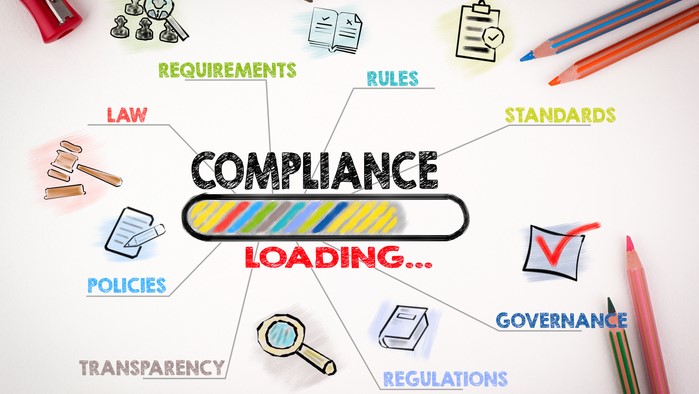A document management system (DMS) prevents many of the headaches associated with compliance. A DMS and its automated workflow enable quick, straightforward confirmation that employees are following company policies while reducing the time they spend on repetitive routine tasks. A digital document management system offers reporting capabilities so you can catch issues before they become problems. It’s a sure-fire way to significantly increase the odds that your organization will pass internal and external compliance audits.
Table of Contents
1. Minimize the risk of non-compliance
1.1 Ditch manual processes?
1.2 Embrace the cloud
1.3 Control access and permissions
1.4 Manage the entire document lifecycle
1.5 Implement version control
1.6 Ensure audit preparedness
1.7 Prioritize data privacy initiatives
2. How document management features support compliance best practices
2.1 Define roles and responsibilities
2.2 Access rights
2.3 Audit trails and version control
The compliance support capabilities of digital document management systems are even more important now that many employees working remotely. If they don’t have the proper tools, there’s a temptation for your staff to use unauthorized messaging software and social media platforms to get their jobs done without considering information security. Team members may also email documents back and forth to each other which can compromise security and make losing track of which version is the final one more likely.
A document management system supplies a single, authorized platform for collaboration and enforces company policies consistently without human intervention.
Minimize the risk of non-compliance with these document management best practices
1. Ditch manual processes

Transform your processes by ending reliance on paper, unstructured electronic files or Excel spreadsheets for keeping track or and storing compliance-related documents. Business processes that rely on error-prone methods like rekeying information into a spreadsheet, especially if it's done by multiple employees, are risky.
Even if all participants do their best to maintain accuracy, errors are bound to occur. If you don’t catch those errors in time, you can fall out of compliance. Tools like DocuWare Intelligent Indexing automate these manual processes using AI-based technology. Intelligent Indexing identifies the most valuable information in a document and converts it into highly structured, usable index data automatically.
In a practical example, a medical device manufacturer used a manual process that involved printing out an Excel spreadsheet for a staff member who checked off each document after they reviewed it. Now the organization uses an automated regulatory compliance workflows that stamp the document with the date, time and name of the reviewer to verify it has been reviewed and approved. Electronic processes like this one reduce errors significantly and provide proof that the required review has been completed.
Additonally integrating electronic signatures into your compliance strategy is essential for strengthening security and adhering to privacy regulations. Unlike paper documents, which are susceptible to forgery, loss, misplacement, or destruction from disasters, digital documents offer robust safeguards. Paper files also lack controlled access, making it easy for sensitive information to be exposed.
There are three types of electronic signatures: simple, advanced, and qualified. Simple signatures are appropriate when verifying the signer’s identity and ensuring security are not major concerns.
For greater assurance, advanced and qualified signatures are recommended. These options are necessary when you must demonstrate the signer’s consent to the document’s terms, confirm the document’s validity, and reliably establish the identity of the person signing. In most cases advanced and qualified signatures are legally binding.
2. Embrace cloud automation
Advanced security and disaster recovery planning are key pillars of a compliance strategy. Cloud platforms set up clear security and privacy requirements and consistently meet them. These platforms supply state-of-the-art documents and internet communication encryption that protects cloud services against protocol downgrade attacks, cookie hijacking, malware and other cyberthreats. They also provide secure backup by mirroring data in offsite data centers. Moving your DMS to the cloud guarantees your organization is meeting compliance standards while reducing the stress on internal IT resources.
3. Control access and permissions
If everyone and anyone can access and make edits to documents and reports, the situation is likely to get out of hand. With a DMS, access to documents and workflow information is based on a comprehensive rights structure. Rights-based control restricts which documents and index data users can store, retrieve, edit, modify and remove from a digital file cabinet. Sensitive data is protected to ensure its authenticity as well as to block unauthorized overrides and workarounds.
4. Manage the entire document lifecycle
.jpg?width=600&name=iStock-1096774350-%5BConverted%5D%20(1).jpg) Since each document category has a different retention schedule, manual approaches are labor-intensive and error-prone. Your company needs a plan, and a document management system simplifies its execution. A DMS manages retention schedules with automatic deletion or with an email notification sent to a staff member before deletion. Automation, based on your business rules, makes it much easier to keep your company compliant with Sarbanes-Oxley, HIPAA, GDPR, FINRA, FERPA, and other federal and state regulations.
Since each document category has a different retention schedule, manual approaches are labor-intensive and error-prone. Your company needs a plan, and a document management system simplifies its execution. A DMS manages retention schedules with automatic deletion or with an email notification sent to a staff member before deletion. Automation, based on your business rules, makes it much easier to keep your company compliant with Sarbanes-Oxley, HIPAA, GDPR, FINRA, FERPA, and other federal and state regulations.
While organizations may be fined for not keeping information for a set time, holding documents beyond their required retention period also puts companies at risk for security breaches and non-compliance with privacy regulations.
5. Implement version control
 Store documents with version control turned on. Look for a document management system with a list view that shows when a document was last edited and who edited it. Avoid confusion and unnecessary changes by limiting access to earlier versions. When you distribute a document for review, you can send a link to the working version, not the document itself so you’re not dealing with different versions being edited by individual team members at the same time.
Store documents with version control turned on. Look for a document management system with a list view that shows when a document was last edited and who edited it. Avoid confusion and unnecessary changes by limiting access to earlier versions. When you distribute a document for review, you can send a link to the working version, not the document itself so you’re not dealing with different versions being edited by individual team members at the same time.
With versioning, correct, approved versions of information are always the ones in use. It also plays an important part in compliance by ensuring that all required changes to a document are made, reviewed and accepted. In a multi-state hotel group, contracts go through a rigorous review process. With a manual system, it was difficult to track mark-ups as the contract passed through the approval chain. By implementing electronic workflow, the contract manager can be sure that all mark-ups are kept, and authorized personnel can go back and see the progression if needed.6. Ensure audit preparedness

Government agencies, nonprofits, and private and public companies can all be subject to an audit. A compliance audit reviews the actions of a company, business, or specific department to see if its regulations and procedures are compliant with company policies. Some compliance audits also determine if a company is acting in an organization meeting external standards, such as federal or industry regulations.
A document management system ensures corporate policies and practices are being followed by producing reports that confirm the use of an organization’s standard operating procedures. With a DMS, reports can be assembled quickly and distributed to auditors efficiently.
This allows your team to respond quickly to auditor requests and maintain greater control over your business information. Every document capture, version and annotation are logged for complete traceability, and every workflow step is recorded for process transparency. This transparency saves time for staff and auditors.
7. Prioritize data privacy initiatives
Data privacy is of increasing concern to every organization. In addition to current compliance requirements outlined by HIPAA, GDPR, the Shield Act, COPPA and industry-specific regulations, be prepared for new and potentially tighter ones to come along in the near future. Compliance with these regulations will mean your company must have a clear picture of the state of your data and the tools to ensure that it’s secure, private and up to date.
With a document management system, you can ensure high data integrity and prove that information is complete, accurate, and stored with administrative, physical and technical safeguards to ensure it is not inappropriately altered, damaged or deleted. In addition to providing internal security, the solution can safeguard customer and membership data. Electronic processes also adapt quickly to changing regulations or new laws. And centrally enforcing company-wide policies is much more efficient than implementing them department by department.
How document management features support compliance best practices
A document management system provides workflow tools that keep your business compliant and protected from fines and litigation.
Define roles and responsibilities 
- Automates user identification and authentication with a unique name and password
- Allows specific access rights to be assigned to each employee
- Assigns privileges at the individual level to help eliminate unauthorized activity
- Ensures a complete audit trail of which document was accessed, by whom, and what actions were taken
Access rights
- Provides multiple levels of control.
- Enables groups to have access to a broad category of documents.
- Can restrict group members as to what they can do with a document. For example, some of the staff may be able to view and print a document but not edit it.
Audit trails and version control

- Provides an increased ability to review and monitor user accounts.
- Emails notifications of violations of security protocols through activity reports
- Offers error tracking and auditing capabilities
- Ensures document integrity by showing exactly what has changed between document versions.
- Guarantees that users are only ever editing the most current version.
- Locks “checked out” documents to prevent multiple people from making changes at the same time.
- Preserves an accurate record of who changed what and when the changes occurred.
- Records every document access and change to create a complete document history for audit preparation and other compliance purposes.
Designing a compliance strategy requires thought, subject matter expertise and collaboration between departments. Executing that design is a job for office automation. Once you define business rules to meet your requirements and those rules come alive through office automation, you can eliminate the risks associated with non-compliance and focus on your core responsibilities. Learn more about DocuWare.
Editor's note: This post has been updated for accuracy and new content has been added.




.jpg?width=600&name=iStock-1096774350-%5BConverted%5D%20(1).jpg) Since each document category has a different retention schedule, manual approaches are labor-intensive and error-prone. Your company needs a plan, and a document management system simplifies its execution. A DMS manages retention schedules with automatic deletion or with an email notification sent to a staff member before deletion. Automation, based on your business rules, makes it much easier to keep your company compliant with Sarbanes-Oxley, HIPAA, GDPR, FINRA, FERPA, and other federal and state regulations.
Since each document category has a different retention schedule, manual approaches are labor-intensive and error-prone. Your company needs a plan, and a document management system simplifies its execution. A DMS manages retention schedules with automatic deletion or with an email notification sent to a staff member before deletion. Automation, based on your business rules, makes it much easier to keep your company compliant with Sarbanes-Oxley, HIPAA, GDPR, FINRA, FERPA, and other federal and state regulations. Store documents with version control turned on. Look for a document management system with a list view that shows when a document was last edited and who edited it. Avoid confusion and unnecessary changes by limiting access to earlier versions. When you distribute a document for review, you can send a link to the working version, not the document itself so you’re not dealing with different versions being edited by individual team members at the same time.
Store documents with version control turned on. Look for a document management system with a list view that shows when a document was last edited and who edited it. Avoid confusion and unnecessary changes by limiting access to earlier versions. When you distribute a document for review, you can send a link to the working version, not the document itself so you’re not dealing with different versions being edited by individual team members at the same time. 






